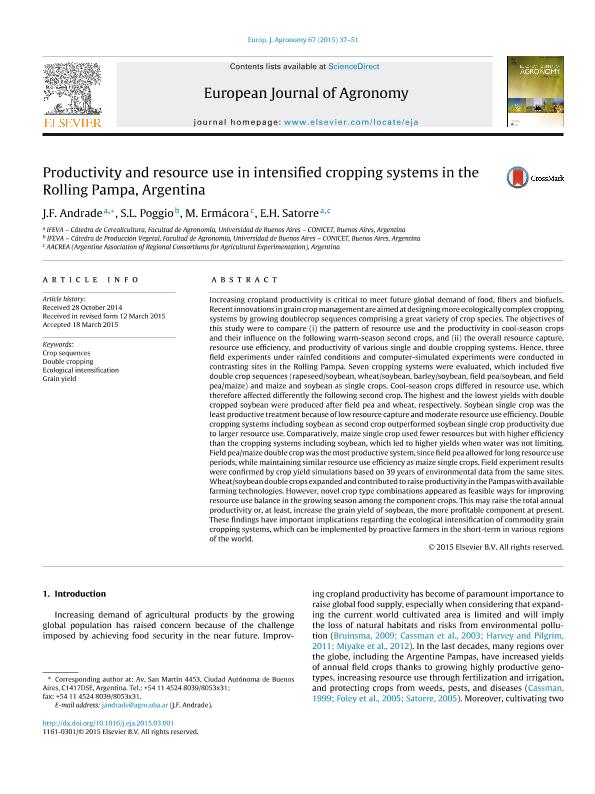Artículo
Productivity and resource use in intensified cropping systems in the Rolling Pampa, Argentina
Fecha de publicación:
04/2015
Editorial:
Elsevier
Revista:
European Journal of Agronomy
ISSN:
1161-0301
Idioma:
Inglés
Tipo de recurso:
Artículo publicado
Clasificación temática:
Resumen
Increasing cropland productivity is critical to meet future global demand of food, fibers and biofuels. Recent innovations in grain crop management are aimed at designing more ecologically complex cropping systems by growing double crop sequences comprising a great variety of crop species. The objectives of this study were to compare (i) the pattern of resource use and the productivity in cool-season crop sand their influence on the following warm-season second crops, and (ii) the overall resource capture, resource use efficiency, and productivity of various single and double cropping systems. Hence, three field experiments under rainfed conditions and computer-simulated experiments were conducted in contrasting sites in the Rolling Pampa. Seven cropping systems were evaluated, which included five double crop sequences (rapeseed/soybean, wheat/soybean, barley/soybean, field pea/soybean, and field pea/maize) and maize and soybean as single crops. Cool-season crops differed in resource use, which therefore affected differently the following second crop. The highest and the lowest yields with double cropped soybean were produced after field pea and wheat, respectively. Soybean single crop was the least productive treatment because of low resource capture and moderate resource use efficiency. Double cropping systems including soybean as second crop outperformed soybean single crop productivity due to larger resource use. Comparatively, maize single crop used fewer resources but with higher efficiency than the cropping systems including soybean, which led to higher yields when water was not limiting. Field pea/maize double crop was the most productive system, since field pea allowed for long resource use periods, while maintaining similar resource use efficiency as maize single crops. Field experiment results were confirmed by crop yield simulations based on 39 years of environmental data from the same sites. Wheat/soybean double crops expanded and contributed to raise productivity in the Pampas with available farming technologies. However, novel crop type combinations appeared as feasible ways for improving resource use balance in the growing season among the component crops. This may raise the total annual productivity or, at least, increase the grain yield of soybean, the more profitable component at present. These findings have important implications regarding the ecological intensification of commodity grain cropping systems, which can be implemented by proactive farmers in the short-term in various regions of the world.
Palabras clave:
Crop Sequences
,
Double Cropping
,
Ecological Intensification
,
Grain Yield
Archivos asociados
Licencia
Identificadores
Colecciones
Articulos(IFEVA)
Articulos de INST.D/INV.FISIOLOGICAS Y ECO.VINCULADAS A L/AGRIC
Articulos de INST.D/INV.FISIOLOGICAS Y ECO.VINCULADAS A L/AGRIC
Articulos(OCA PQUE. CENTENARIO)
Articulos de OFICINA DE COORDINACION ADMINISTRATIVA PQUE. CENTENARIO
Articulos de OFICINA DE COORDINACION ADMINISTRATIVA PQUE. CENTENARIO
Citación
Andrade, José Francisco; Poggio, Santiago Luis; Ermacora, Mario Roberto; Satorre, Emilio Horacio; Productivity and resource use in intensified cropping systems in the Rolling Pampa, Argentina; Elsevier; European Journal of Agronomy; 67; 4-2015; 37-51
Compartir
Altmétricas




